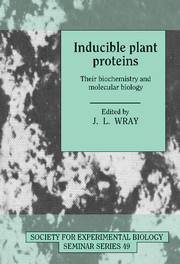Book contents
- Frontmatter
- Contents
- List of Contributors
- Preface
- Metal-binding proteins and metal-regulated gene expression in higher plants
- Phosphate starvation inducible enzymes and proteins in higher plants
- Nitrate reduction in higher plants: molecular approaches to function and regulation
- Inducibility of the glutamine synthetase gene family in Phaseolus vulgaris L.
- Expression and manipulation of genes involved in phenylpropanoid biosynthesis
- Biochemistry and molecular biology of CAM
- ABA- and GA-responsive gene expression
- Regulation of gene expression, ethylene synthesis and ripening in transgenic tomatoes
- Induction of nodulin genes and root nodule symbiosis
- Systemic acquired resistance: an inducible defence mechanism in plants
- Biochemistry and molecular biology of the anaerobic response
- The heat shock response in transgenic plants: the use of chimaeric heat shock genes
- Biochemistry and molecular biology of cold-inducible enzymes and proteins in higher plants
- GBF-1, GBF-2 and GBF-3: three Arabidopsis b-Zip proteins that interact with the light-regulated rbcS-1A promoter
- Index
GBF-1, GBF-2 and GBF-3: three Arabidopsis b-Zip proteins that interact with the light-regulated rbcS-1A promoter
Published online by Cambridge University Press: 06 July 2010
- Frontmatter
- Contents
- List of Contributors
- Preface
- Metal-binding proteins and metal-regulated gene expression in higher plants
- Phosphate starvation inducible enzymes and proteins in higher plants
- Nitrate reduction in higher plants: molecular approaches to function and regulation
- Inducibility of the glutamine synthetase gene family in Phaseolus vulgaris L.
- Expression and manipulation of genes involved in phenylpropanoid biosynthesis
- Biochemistry and molecular biology of CAM
- ABA- and GA-responsive gene expression
- Regulation of gene expression, ethylene synthesis and ripening in transgenic tomatoes
- Induction of nodulin genes and root nodule symbiosis
- Systemic acquired resistance: an inducible defence mechanism in plants
- Biochemistry and molecular biology of the anaerobic response
- The heat shock response in transgenic plants: the use of chimaeric heat shock genes
- Biochemistry and molecular biology of cold-inducible enzymes and proteins in higher plants
- GBF-1, GBF-2 and GBF-3: three Arabidopsis b-Zip proteins that interact with the light-regulated rbcS-1A promoter
- Index
Summary
Introduction
Gene transcription requires the interplay between transcription factors with their cognate promoter elements. Structural and functional analyses of many of these transcription factors revealed a modular protein structure, composed of a DNA-binding domain and a transcriptional activation domain (Johnson & McKnight, 1989; Mitchell & Tjian, 1989). The DNA-binding domain of the b-Zip proteins is characterised by the presence of a basic region with an adjacent leucine zipper (Landschulz et al., 1988). Whereas the basic region is required for specific protein–DNA interaction and directly contacts the DNA, the leucine zipper facilitates homodimer and heterodimer formation (Hu et al., 1990 and references therein). Transcriptional activation domains are often enriched in acidic amino acids (Hope & Struhl, 1987; Ptashne, 1988), glutamines (Courey et al., 1989) or prolines (Mermod et al., 1989).
Although many DNA-binding proteins have been identified in plant nuclear extracts, only a few cDNA sequences encoding these proteins have been cloned. Plant b-Zip proteins for which cDNAs have been isolated include the wheat proteins, EmBP-1 (Guiltinan et al., 1990) and HBP-1 (Tabata et al., 1989), the maize proteins OCSBF-1 (Singh et al., 1990) and Opaque2 (Schmidt et al., 1990) and the tobacco proteins TGA1a and TGA1b (Katagiri et al., 1989). HBP-1, as originally identified in crude nuclear extract, was shown to interact with the hexamer (Hex) motif TGACGT found in several histone promoters (Mikami et al., 1987, 1989a,b,c). The cDNA identified as encoding HBP-1 was isolated by screening an expression library for specific DNA binding to an oligonucleotide derived from the wheat histone 3 promoter and containing the conserved Hex motif (Tabata et al., 1989).
- Type
- Chapter
- Information
- Inducible Plant ProteinsTheir Biochemistry and Molecular Biology, pp. 289 - 304Publisher: Cambridge University PressPrint publication year: 1992

